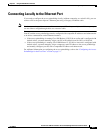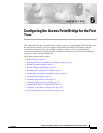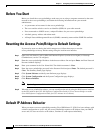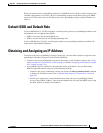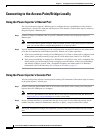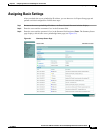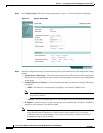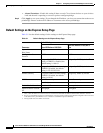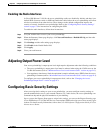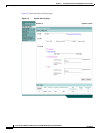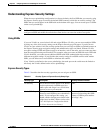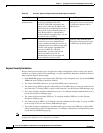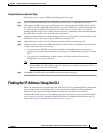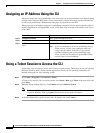
5-7
Cisco Aironet 1300 Series Outdoor Access Point/Bridge Hardware Installation Guide
OL-5048-02
Chapter 5 Configuring the Access Point/Bridge for the First Time
Assigning Basic Settings
• IP Subnet Mask—Enter the IP subnet mask provided by your network administrator so that the IP
address can be recognized on the LAN. If DHCP is enabled, leave this field blank.
• Default Gateway—Enter the default gateway IP address provided by your network administrator.
If DHCP is enabled, leave this field blank.
• SNMP Community—If your network is using SNMP, enter the SNMP Community name provided
by your network administrator and select the attributes of the SNMP data (also provided by your
network administrator).
–
Read-Only—indicates that the access point/bridge allows only SNMP read access. Using this
option, an SNMP user cannot change access point/bridge configuration settings.
–
Read-Write—indicates that the access point/bridge allows SNMP read and write access. This
setting allows an SNMP user to change the access point/bridge configuration.
• Role in Radio Network—Click on the check box that describes the role of the access point/bridge
on your network.
–
Install Mode—Activates the bridge install and alignment mode. Specifies that the unit
automatically determines the network role. If the init is able to associate to another Cisco
Aironet root bridge within 60 seconds, the unit assumes a non-root bridge role. If unable to
associate with another Cisco Aironet root bridge within 60 seconds, the unit assumes a root
bridge role.
You can also pre-configure the unit into root bridge or non-root bridge modes and avoid the
60-second automatic detection phase.
–
Root—Specifies that the unit is operating as a root bridge and connects directly to the main
Ethernet LAN network. In this mode, the unit accepts associations from other Cisco Aironet
non-root bridges and wireless client devices.
–
Non-root—Specifies that the unit is operating as a non-root bridge and connects to a remote
LAN network and must associate with a Cisco Aironet root bridge using the wireless interface.
–
Root Access Point—Specifies that the unit operates as an access point connected to the main
Ethernet LAN network. In this mode, wireless client devices are allowed to associate to the
access point.
–
Workgroup Bridge—Specifies that the unit operates as a workgroup bridge connected to a
small wired Ethernet LAN network through an Ethernet hub or switch. The workgroup bridge
must associate to a Cisco Aironet access point or a Cisco Aironet bridge.
Note In Cisco IOS Release 12.3(2)JA2 or earlier, the access point/bridge is default configured in
bridge install mode with automatic bridge detection activated. In Cisco IOS Release 12.3(4)JA,
the access point/bridge is default configured in root access point mode.
• Optimize Radio Network for—Use this setting to select either preconfigured or customized
settings for the access point/bridge radio.
–
Throughput—Maximizes the data volume handled by the access point/bridge but might reduce
its range.
–
Range—Maximizes the access point/bridge’s range but might reduce throughput.
–
Default—The access point/bridge retains default radio settings that are designed to provide
good range and throughput.
–
Custom—The access point/bridge uses settings you enter on the Network Interfaces
Radio-802.11g Settings page. Clicking Custom takes you to the radio settings page.



